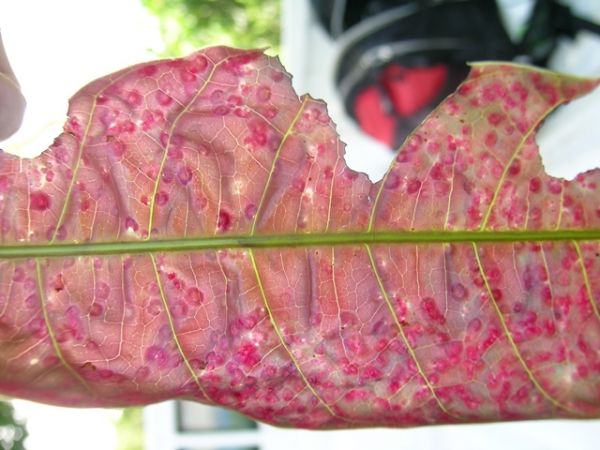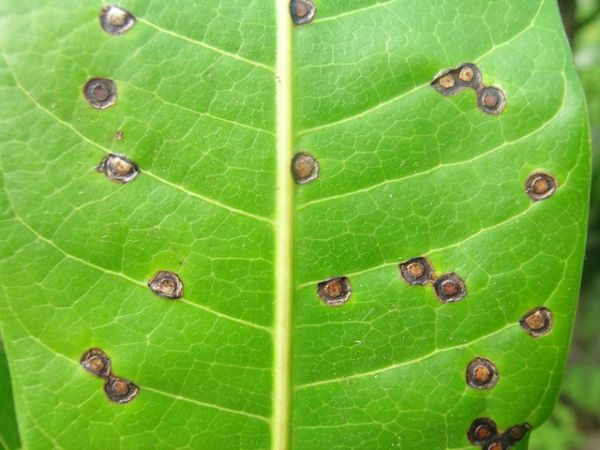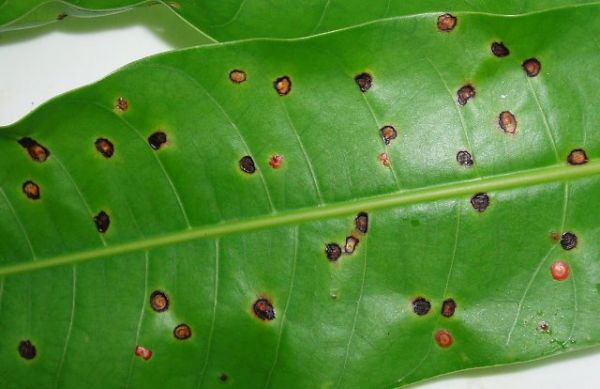Exotic Pest: Mango Leaf Gall Midge
Mango leaf gall midge (MLGM) (Procontarinia pustulata) is a tiny fly, similar to a mosquito, that is found in Papua New Guinea, on some Torres Strait islands and on the Australian mainland near the tip of Cape York Peninsula. To date, MLGM has not been detected in Australian mango production areas.

A young mango leaf infested with MLGM. © Department of Agriculture and Fisheries.

Leaf galls caused by MLGM are roundish, raised, about 2-3 mm in diameter and can be different colours, depending on their age. © Department of Agriculture and Fisheries.
MLGM larvae feed within plant tissue causing abnormal growth called galls on leaves.
The MLGM lifecycle starts when the female fly lays eggs, one at a time, under the surface of tender young mango leaves. After only a few days, the egg opens inside the leaf and a distinctive hollow gall forms around the hatched larva. When the larva matures, it exits the gall through a tiny hole and descends to the ground where it pupates in the soil. Following pupation, the adult fly emerges, and the lifecycle begins again. MLGM is capable of completing its lifecycle several times each year.
Severe MLGM infestations can result in over 100 galls per leaf, causing leaf deformation, reduced photosynthesis and leaf drop. As a consequence, fruit production may be affected.
HOW DO I LOOK FOR MLGM?
Be suspicious if there is more leaf drop from your mango trees than usual or if leaves are misshapen or have roundish holes. If you notice high levels of leaf drop, inspect the leaves for the presence of galls.
Visible on both sides of the leaf, each gall is rounded, like a blister, approximately 2–3 mm in diameter and 0.4–0.7 mm high. The galls can be green, yellow, red or brown to brown-black in colour depending on their age. Old leaf galls eventually fall out, leaving holes in the leaves (sometimes called shot holes).

Closer view of mature MLGM leaf galls.© Department of Agriculture and Fisheries.
WHAT COULD MLGM BE CONFUSED WITH?
The fungal disease mango scab could be confused with MLGM because scab also causes roundish raised leaf spots on both sides of the leaves. Scab is generally brown-black, sometimes with a yellow halo, and usually turns grey with age.
If you are unsure or suspect mango leaf gall midge, report it to the Exotic Plant Pest Hotline on 1800 084 881.
HOW CAN I PROTECT MY ORCHARD?
Growers can protect their farms by practising good farm biosecurity. Always buy high quality plant propagation material from a trusted source and check the plants before you buy them or on arrival to ensure they are pest and disease free.
Monitor the health of your orchard. As part of your pest management program, look for galls on leaves. If you suspect MLGM, report it.
In partnership with Plant Health Australia, the Australian Mango Industry Association (AMIA) have produced the Orchard Biosecurity Manual for the Mango Industry; which provides excellent advice to growers on practical ways to implement effective biosecurity measures on farms. The Farm Biosecurity website also contains many useful resources to assist commercial growers to protect their orchards.
ABIDE BY MOVEMENT RESTRICTIONS
Be aware of and comply with biosecurity movement conditions relevant to the state you are in. Movement of mango fruit, plant material and associated soil may be restricted. For information about interstate requirements go to the Australian Interstate Quarantine website.
In Queensland, the far northern biosecurity zones limit the movement of MLGM. Observe movement restrictions if you are travelling to or around the Cape York Peninsula, or if you live there.
If you suspect MLGM, you must report it. Contact the Exotic Plant Pest Hotline on 1800 084 881.
Find out more:
|
VISIT |
VISIT |